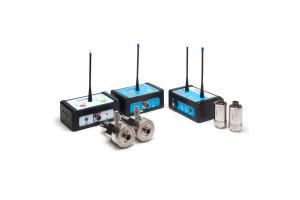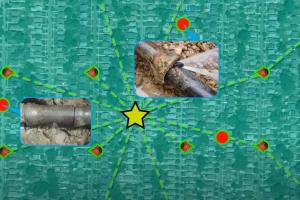London, Ontario Protects Critical Water Network with Pipe Condition Assessment
Many water asset managers are adopting a pyramid approach to pipe condition assessment. On a selected group of assets, the concept uses cost-effective methods to collect information where possible, and progress to high resolution and high-cost inspection options where needed. This approach formed the structure of the City of London, Canada’s (“the City”) project plan for its Elgin large diameter pipeline. Following the successful inspection of the 15.5 miles steel and PCCP transmission mains, the City was able to confirm that the water mains were in good to excellent condition and that they did not require any short or medium-term capital renewal projects allowing the City to allocate their limited budget towards water mains that had a greater level of degradation and need for renewal.
Home to more than 380,000 residents, the City recognized the need for a proactive approach toward maintaining a healthy water network as the city continues to develop, along with an increase in transportation projects. Many of these movements were taking place along the Elgin Pipeline corridor, an important large diameter water main network that provides approximately 25% of the City’s water from Lake Erie.
Situation
Taylor Eckert, Project Engineer for the City London said, “We had some major projects, including a road widening and pipe life-cycle replacement. By getting ahead of these projects with inspection and understanding pipe’s condition, it gave us the opportunity to piggyback on the larger transportation projects and save on replacement investment.”
The assumption was that the pipeline was in good condition, however, they needed to confirm this assumption with evidence-based information to mitigate the likelihood of failure and extend the life of these high-risk assets, while at the same time, meeting legislative requirements. The City sought solutions from Echologics® ePulse® condition assessment technology and EchoWave® leak detection services.
Situation
Following a comprehensive evaluation process, ePulse® was chosen to assess the minimum average structural stiffness of approximately 9 miles of large diameter PCCP mains and EchoWave® leak detection was completed on 6.5 miles of large diameter steel mains. This segment, installed in the 1990’s, consisted of water mains with diameters ranging from 35˝to 41˝. The goal was to conduct a due diligence inspection to determine the current pipe condition and put forth recommendations for the City to make evidence-based asset management decisions to replace, rehabilitate, defer, or monitor specific lengths of this pipeline.
“As water pipes increase in diameter, they also increase in criticality and complexity. Transmission pipes are site specific installations. Each transmission pipe has been designed to ensure safe operation given local loading and operating considerations. Decades after a transmission pipe has been installed, design standards, actual loading conditions and consequences of failure may change significantly. Hence, understanding the current structural state and operating requirements of each transmission pipe is a critical step towards making evidence-based asset management decisions,” said Alain Lalonde, Regional Manager, Water Management Solutions of Mueller.
ePulse® technology combines acoustic data measured in the field with information about a pipe’s construction to calculate the average minimum remaining structural pipe wall stiffness over the measured segment. The methodology employed is known as the cross-correlation method. As a pipe degrades, the velocity at which sound waves travel through the pipe decreases linearly, forming the basis for the technology. The pipe assessment is performed by bracketing a section of pipe between two sensors that are attached to an existing valve or pothole. An out-ofbracket noise is then created by tapping on a valve or directly on the pipe via a daylighting pothole.
The field team measures the distance between the two sensors and proprietary software calculates the time taken for the acoustic signal to propagate between the two sensors. The wall stiffness is determined using the measured sound wave propagation speed through the pipe and comparing that value to the wave speed of a new perfect condition concrete pipe. This calculation takes into account the pipe and water properties for the specific classes of concrete pipe tested. For this particular project, all pipe properties were determined from drawings provided by the City.
Michelle Morris, Transportation Design Engineer for the City of London said, “When looking into areas such as ease and resolution of inspection and low operational risk, ePulse® checked all the boxes. Echologics also worked with us to formulate a grading scheme to quantify the pipe’s condition and detailed next steps which should be taken for segments exhibiting each particular grading.” When asked how the exercise had contributed to the City’s overall asset management plan, Michelle added, “Having this concrete data and grade scheme in place, we can easily add this into our database which will help with ths scope of work for future by establishing a baseline with historical data.”
Echologics field engineers also worked with the City’s water engineers to ensure a smooth migration of inspection data into their existing GSI database – making it more accessible and easier to understand by the asset management team.
For a more comprehensive assessment of the Elgin Pipeline, Echologics, as the prime contractor, also teamed up with several expert sub-consultants to conduct in-depth high-resolution testing and review. A case of such collaboration was between Echologics and Simpson Gumpertz & Heger Inc. (SGH). ePulse® provided the average remaining structural stiffness of each length of water pipe tested, and identified lengths of pipe where significant structural deterioration had occurred. These findings were paired with Simpson Gumpertz & Heger Inc. (SGH)’s structural evaluation and failure risk analysis result, to identify at-risk sections of the pipeline.
Other collaborators who were equally critical in the project include AECOM Canada, CorrPro, and Rock Solid Group, engaged to provide support in their own area of expertise.
Results
Based on high-resolution ePulse® analysis and stiffness measurement, there was sufficient data to show that close to 80% of the tested mains appeared to be in good condition and will not require further investigation. However, periodic inspection and maintenance work is encouraged. The remaining 20% showed some signs of deterioration and will require attention in the future.
The added advantage of this acoustic technology is the ability to conduct leak detection simultaneously. No leaks were discovered at the time of the survey on the Elgin Pipeline. The fact that no existing leaks were found on this pipeline was an early indicator that no immediate or emergency rehabilitation or repair actions was required.
After the six-week period, the City could move forward with peace of mind, knowing that this critical pipeline is in good condition and focus on forecasting and projecting budget and predication of the lifecycle of the pipes respectively.
Following this transmission pipe inspection, the City engaged in further transmission pipe assessment projects with Echologics and found value in adding Echologics approach to their toolset along with higher resolution pipe assessment technologies. When recommending additional investments in Echologics transmission pipe inspections to the City council, the City’s technical team shared, “After evaluation of the RFP, the City’s evaluation team determined Echologics provided the best value and their technology presented the least amount of operational risk.”





